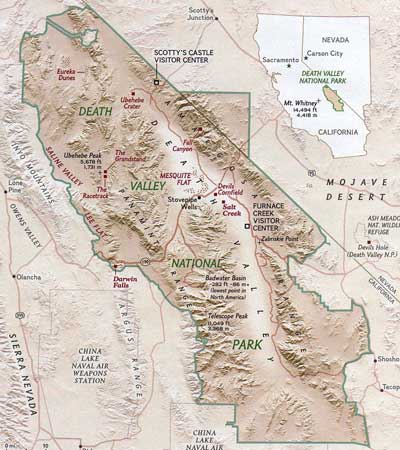DEATH VALLEY (Day 10 - part 1)
In the morning, we packed up and grabbed some breakfast across the street.

Sunrise


All-you-can-eat buffet

Preparing for the day
We set out across Panamint Valley, over the Panamint Mountains, and entered into Death Valley.


(left) Death Valley is entirely contained within the Mojave Desert. ... (right) Click for a larger view

Crossing the Panamint Valley with the Panamint Mountains in the distance




First views of Death Valley ... and an obviously insane cyclist!


Descending into the valley. ... Fortunately it wasn't too hot yet.
We passed several of the tourist spots (figuring we'd hit them on the way back out) and beelined to the Furnace Creek Visitor Center.





Click for a larger image
Death Valley National Park is the largest national park in the lower 48 states, with 3 million acres of desert wilderness. It:
- is the lowest point in North America
- os the hottest, driest area in the country
- has a diverse fossil record
- has over 100 years of well-preserved mining history
- has unique plants and animals
- has all five types of sand dunes
This was a rough area. It was dry and deadly. Bandits and thieves hid herds of stolen horses here. It got its name from an ill-fated wagon train in 1849. In attempt to avoid the snow-covered Sierra Nevada and shorten their route to the mines of central California, the Bennett-Arcan party ended up in this desert where they lost animals, wagons and even the lives of some. When they were finally rescued, one of them turned back and said "Goodbye, Death Valley".




(left) Temperature isn't too bad today, for October. ... (right) Urine color chart for dehydration

Death Valley is one of the hottest places in the world. Summer temperatures can reach 120 degrees F during the day and not drop below 100 F at night. It's also the driest place in North America, with an average rainfall of less than 2 inches per year on the valley floor. The surrounding mountains capture all the moisture of passing storms, creating a 'rain shadow'.
"It was so hot that swallows in full flight fell to the earth dead."
- Oscar Denton, caretaker of Furnace Creek Ranch in July 1913, during a record heat of 134 degrees F.






Past residents ... and their preserved tracks


The three main types of mining were gold, borax and talc.
We then set out to explore the sites.

Map of the sites we stopped at (click for a larger view)
Our first stop was Badwater Basin.

Currently a luxury resort called The Oasis, this used to be The Furnace Creek Inn. It was constructed by the Pacific Coast Borax Company in 1927 in an effort to open Death Valley to tourism as a new source of revenue.



Uh... hopefully he knows what he's doing!

Approaching the salt flats


return • continue

